
Photo from wikipedia
(1) Background: There is a substantial lack of knowledge of the biochemical mechanisms by which weight loss and weight regain exert their beneficial and adverse effects, respectively, on cardiometabolic outcomes.… Click to show full abstract
(1) Background: There is a substantial lack of knowledge of the biochemical mechanisms by which weight loss and weight regain exert their beneficial and adverse effects, respectively, on cardiometabolic outcomes. We examined associations between changes in circulating metabolites and changes in cardiometabolic risk factors during diet-induced weight loss and weight loss maintenance. (2) Methods: This prospective analysis of data from the Satiety Innovation (SATIN) study involved adults living with overweight and obesity (mean age=47.5). One hundred sixty-two subjects achieving ≥8% weight loss during an initial 8-week low-calorie diet (LCD) were included in a 12-week weight loss maintenance period. Circulating metabolites (m=123) were profiled using a targeted multiplatform approach. Data were analyzed using multivariate linear regression models. (3) Results: Decreases in the concentrations of several phosphatidylcholines (PCs), sphingomyelins (SMs), and valine were consistently associated with decreases in total (TChol) and low-density lipoprotein cholesterol (LDL-C) levels during the LCD. Increases in PCs and SMs were significantly associated with increases in TChol and LDL-C during the weight loss maintenance period. Decreases and increases in PCs during LCD and maintenance period, respectively, were associated with decreases in the levels of triglycerides. (4) Conclusions: The results of this study suggest that decreases in circulating PCs and SMs during weight loss and the subsequent weight loss maintenance period may decrease the cardiovascular risk through impacting TChol and LDL-C.
Journal Title: Nutrients
Year Published: 2021
Link to full text (if available)
Share on Social Media: Sign Up to like & get
recommendations!